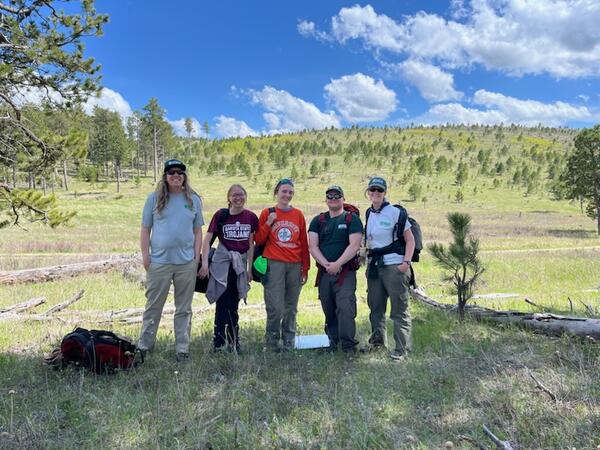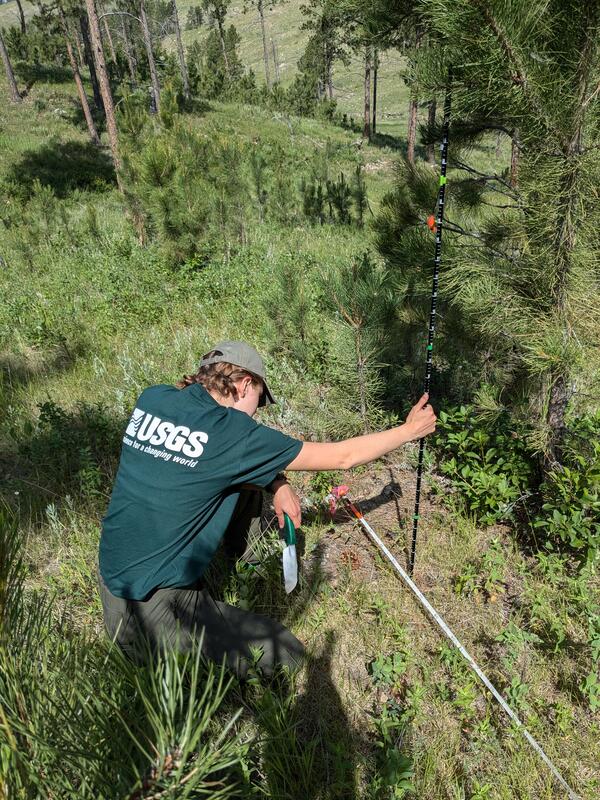LANDFIRE, short for Landscape Fire and Resource Management Planning Tools, is a key national data source for the management of wildfires, management of the plant materials that fuel fires, and planning for prescribed fires across all 50 states and the U.S. territories.
Lidar captures scientists, interns during fieldwork
Some interns might fetch coffee or file papers.
But this summer at the USGS Earth Resources Observation and Science (EROS) Center, nine interns dove straight into work with artificial intelligence/machine learning, cloud masking, data management, fire ecology, business and coding—projects that benefit people directly and offered the interns unbeatable practical experience.
Fire Science Project
Three of the interns were lucky enough to do fieldwork, researching the 2000 Jasper Fire in Black Hills National Forest in South Dakota and the 2021 KNP Complex Fire in Sequoia National Park in California. They provided support for ongoing EROS Fire Science projects.
“We focused on mixed severity fires, studying fuels, the fire severity, fire behavior and how the ecosystem is recovering,” said intern Grace Parrott. She recently graduated from Luther College in Decorah, Iowa.
For the project, the interns scanned 20-meter diameter circular plots using land-based lidar to test its accuracy. Lidar, which stands for “light detection and ranging,” works similar to radar or sonar but with laser pulses. By measuring the time it takes for the light to bounce back from a target, lidar instruments can create highly accurate 3-D maps.
But is lidar as accurate as traditional forestry measurements? The only way to determine that is to perform the scans and use the old-school methods on the same plots. “We measured tree height, diameter at breast height (1.37 meters), canopy base height, and litter, which includes sticks, among other things,” said Katelyn Woolfrey, an intern from the University of Virginia, located in Charlottesville.
The purpose of comparing lidar to traditional fieldwork is to save time. While it often takes up to 3 hours—and sometimes even days—to measure a plot by hand, it takes only about 20 minutes to move the lidar device to 5 different spots and scan the plot. If lidar proves to be roughly comparable to fieldwork, fire researchers can cover more ground and get more data.
“We are collecting field data to help demonstrate how lidar observations can scale from point to landscape to regional scales,” said EROS Fire Science Lead Birgit Peterson. “I hope the interns were exposed to different data, tools and techniques and that they have confidence that they can apply these to any new experiences that they have in the future.”
Hazel Mebius, who will be a senior at Dakota State University (DSU) in Madison, South Dakota, this fall, said the intern experience gave her a new perspective on fire. “When you hear about wildfire, you think houses might get burned down or something—which is definitely bad,” she said. “But I learned all about erosion and landslides after fire, which I never really thought about till now.”
All three interns also were struck by the varying effects of fire severity: Some severely burned areas of the 24-year-old Jasper Fire still show zero regrowth, but they viewed low-severity areas in Sequoia National Park where regrowth is evident only three years post-fire.
Cloud Mask Project
Two interns were able to leverage their interest in artificial intelligence and machine learning in a project that benefits a wide range of remote sensing scientists and data users: cloud masking.
“Accurate cloud detection is crucial for reliable remote sensing data analysis,” said Hunter Hagedorn, an intern who just finished his freshman year at South Dakota State University in Brookings. “Clouds and their shadows can obscure land and water features, impacting the accuracy of environmental monitoring, agriculture assessments and climate studies. Effective cloud masking ensures that only clear, useful data is utilized in analysis.”
He teamed up with fellow intern Carson Price, a graduate student at South Dakota School of Mines in Rapid City, using convolutional neural networks to complete the project. “Neural networks are the basis for lots of machine learning applications,” Price said. “Ultimately, it’s just a big function that you can train. It mimics the human brain and its neurons to learn different complex tasks.”
Kevin Moe worked closely with Hagedorn and Price this summer and noted the “soft skills” the interns acquired at EROS, including meeting for morning “stand-ups” to detail the status of each person’s work.
“Not only did they get to work on a state-of-the-art AI/ML project, but they got the real-world experience of picking up a project that was started by the previous year’s interns,” said Moe, the Solutions Architect for KBR, the primary contractor at EROS. “When you come into the industry, that’s a skill you need. You’re not always writing brand new code, so you have to look at the existing code. Are you revamping it or adding to it? That’s invaluable experience.”
Wide Breadth of Opportunities
The other four interns participated in projects across the center, writing code and creating software that directly supports work at EROS while acquiring key skills.
Ground Station Software Engineering: Joshua Beach, who will be a junior at SDSU this fall, acquired skills in Python, Perl, git and bash during his internship. Working as the first-ever intern for the Ground Station Operations team, he’s been creating a software tool to convert the satellite Confirmed Contact Schedule for Landsat 8 and 9 to the correct format for new equipment coming to the EROS ground station.
“I was pretty much trying to find ways to save time on some of the more repetitive human tasks that have to be done,” Beach said. “My main task this summer was trying to build a converter for the confirmed schedule file for satellites. It tells our antennas where to direct themselves when the satellite is doing a pass overhead.”
Science Division: Sam Nelson grew up in Sioux Falls, South Dakota, where EROS is located but attends Portland State University in Oregon, where he will complete his degree in computer science next spring. He spent the summer working on the Shared Web Infrastructure Management (SWIM) as part of his internship with C2G, a subcontractor for KBR.
“It’s used by a team of around 30 software engineers and supports 15 projects at EROS and provides data processing, distribution and visualization tools,” he said. “I'm building an uptime monitor that monitors the status of each website every 5 minutes, and if it’s down, it will send an email to anyone who’s working on those websites.” He had to learn a new web application framework to accomplish his internship work. “I had zero experience with this coming in, so that was fun to try to figure out, and now I’m using it in my tasks.”
Data Management and Information Delivery (DMID): Matt Rattenborg, a senior GIS and geography major at SDSU, performed a variety of tasks as a C2G intern, including monitoring the daily ingest and archiving of data from Indian Space Research Organization (ISRO) satellite overpasses, which are downloaded at the EROS ground station.
“I was a little nervous coming in here because I had no coding experience,” Rattenborg said, but he learned on the job and will continue to learn a software that creates metrics and reports as he works part time during the school year. He also helped pack up pallets of Bureau of Land Management film for transportation over the summer.
Engineering and Data Management: Ryker Pedde is a veteran intern at EROS, back for a fourth summer after completing his master’s in economics at SDSU. “I automated an existing Amazon Web Services (AWS) S3 (Simple Storage Service) report. It’s something we’ve always monitored, but previously it was a manual process,” he said. “I was tasked with monitoring the costs of all of the accounts of different projects that we have that are hosted in AWS up in the cloud.”
Pedde also learned skills to help automate other existing reports for Data Management. He’ll start full time as a KBR contractor at EROS this fall with the official title of data manager for the Data Processing and Archive System, helping out with cost reporting and getting information for white papers or managers.
Extending Work at EROS
Like Pedde, Parrott will be joining the EROS staff full time—in her case as a federal geographer fellow in fire science. In addition, all but one of the interns returning to school will keep working for EROS on the projects they built this summer.
That continuing relationship is one of the goals of the EROS recruitment team, said Erin McManus, a senior recruiter in the Science and Space Division for KBR. McManus travels to career fairs at SDSU, DSU, South Dakota School of Mines and other area schools, and several of the summer interns cite that point of contact as the reason they applied at EROS.
In fact, 7 of the 9 interns hail from within a one-hour radius of Sioux Falls. Beach, for example, grew up in Hawarden, Iowa, and remembered a school field trip to EROS when he was a kid. When he stopped at the KBR booth, he already had a connection.
For others, “they don't always know what we’re doing or who we are,” McManus said. “But once we tell them a little bit about it at these career fairs, it really draws them in.”
Some interns find out about EROS via other routes. Parrott learned about the USGS/NAGT (National Association of Geoscience Teachers) Cooperative Summer Fellowship Program from a professor. Woolfrey worked for the EROS Fire Science team remotely during the school year as part of the Virtual Student Federal Service program, and the team let her know about the internship.
Whatever route interns take to arrive at EROS, McManus said, “We want this to be beneficial for both parties. Seeing that skillset for the future is really what we want to do, and ideally, we’d like them to be employees. And we do see that quite often.”
‘Never Stopped Learning’
All of the interns said they gained insight not only into what EROS does but into how their particular skills fit into real-world work as opposed to an academic setting.
“We never stopped learning anything new,” said Price. “And we got to work with people that have knowledge and experience, working on a project with a purpose that people will actually use sometime.”
He also urged prospective interns to go ahead and ask questions. Mebius concurred. “Don’t be afraid to talk to people. They’re more than happy to talk to you about what they’re working on and why they find it interesting,” she said.
Woolfrey, who noted that she was probably one of the few biology/statistics students who has ever interned for EROS, said others should consider the opportunity. “My advice would be not to pigeonhole yourself because I never thought of myself as going into wildfire research when I started my biology major,” she said.






















